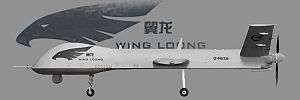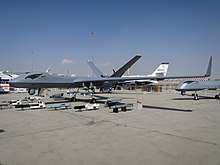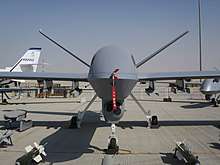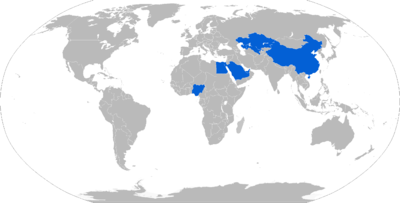CAIG Wing Loong
| Pterodactyl I | |
|---|---|
 | |
| Role | MALE UCAV |
| Manufacturer | Chengdu Aircraft Industry Group |
| Designer | Chengdu Aircraft Design Institute |
| First flight | 2009 |
| Status | in service and in production[1] |
| Primary users | People's Liberation Army Air Force Royal Saudi Air Force Egyptian Air Force United Arab Emirates Air Force |
The Chengdu Pterodactyl I (Chinese: 翼龙-1[2]; pinyin: Yìlóng-1), also known as Wing Loong, is a Medium-Altitude Long-Endurance (MALE) unmanned aerial vehicle (UAV), developed by the Chengdu Aircraft Industry Group in the People's Republic of China. Intended for use as a surveillance and aerial reconnaissance platform, the Pterodactyl I is capable of being fitted with air-to-surface weapons for use in an unmanned combat aerial vehicle (UCAV) role.[1] Based on official marketing material released by CADI, the Pterodactyl can carry the BA-7 air-to-ground missile, YZ-212 laser-guided bomb, YZ-102A anti-personnel bomb and 50-kilogram LS-6 miniature guided bomb.[3]
Design and development
Designed and developed by the Chengdu Aircraft Design Institute (CADI), a division of the Aviation Industry Corporation of China (AVIC),[4][5] the Pterodactyl I bears a distinct similarity in appearance to the Predator/Reaper family of drones developed by the United States.[5][6] The drone is capable of being fitted with a variety of sensors, including a forward looking infrared turret and synthetic aperture radar.[4] In addition, the aircraft is capable of carrying weapons.[6] The Pterodactyl I's total payload capacity for sensors and weapons is 200 kilograms (440 lb).[4]
Operational history
According to Chengdu, the Pterodactyl I has been undergoing flight testing and has proven successful, with the flight test program including weapons tests of both bombs and air-to-surface missiles.[4]
A model of the Pterodactyl I was displayed at the 2010 China International Aviation and Aerospace Exhibition at Zhuhai, the first public acknowledgment of the program;[5][6] however, it was claimed by AVIC that the aircraft had been displayed at the 2008 airshow.[4] The aircraft has been approved for export by Chinese authorities; the Pterodactyl I was evaluated by Pakistan, but was not selected for procurement.[4]
One example of the type was known to have been lost in an accident during 2011.[7]
China National Aero Technology Import & Export Corp is managing exportation of Pterodactyl UAV. An unknown number of Pterodactyl UAVs were purchased by Saudi Arabia in May 2014.[8]
Since 2011, China has also sold the Wing Loong to several countries in Africa and the Middle East, including Nigeria, Egypt, and the United Arab Emirates, at an estimated $1 million per unit.[9]
In March 2017, the Egyptian Air Force launched a number of airstrikes in North Sinai’s cities of El Arish, Rafah, and Sheikh Zuweid, as part of the operations conducted by the Egyptian Armed Forces against militants. Most of the strikes, which targeted stationing points and moving vehicles, were carried out by Wing Loong UCAVs leaving 18 militants killed.[10][11]
Variants



A total of six variants of Wing Loong have been identified and they are:
- Pterosaur I: First member of Wing Loong series, with program of Wing Loong begun in May 2005. Maiden flight was completed in October 2007 and payload evaluation flight was completed a year later in October 2008.[12] This first model of Wing Loong series lacked the bulge at the nose tip of the fuselage due to the lack of a satellite antenna,[12] and while the English name used by the developer differed from later models, the Chinese name remains the same, and so is the name Wing Loong for the entire series.[13][14][15][12][16] The lack of satellite antenna results in cheaper cost, with the reduction of the maximum control range around to 200 km.[17] This model is no longer actively marketed when Pterodactyl I appeared, but is still available as a cheaper alternative up on potential customers’ request.
- Pterodactyl I: The second member of Wing Loong series is distinguished from the earlier Pterosaur I in that there is a bulge at the nose tip of the fuselage to house a satellite antenna, and this is the version most widely publicized and actively marketed as a surveillance platform. United Arab Emirates and Uzbekistan were reported to be the first two foreign customers of Pterodactyl I.[18]
- Sky Saker: Sky Saker is a derivative of Wing Loong developed by Norinco mainly intended for export. The Chinese name is Rui Ying (锐鹰), meaning Sharp Eagle, but the English name adopted by the developer is Sky Saker.[19] Sky Saker / Rui Ying carries both a miniature synthetic aperture radar and an electro-optical pod to perform reconnaissance in both the visible light and radar spectra.[20] The capability of Sky Saker / Rui Ying has been exaggerated by many Chinese internet sources claiming that it has both scout and strike capabilities at the same time, but this has been proven to the contrary. According to all info released by Norinco itself (as of 2015), the UAV can employ only a single capability at a time: when the UAV carries the reconnaissance payload, no weaponry is carried. Similarly, when weaponry is carried, the reconnaissance payload is absent.[20]
- WJ-1: The first land attack version of Pterodactyl I, which is a weapon platform without the reconnaissance/targeting pod under the chin. The designation WJ stands for Wu-Zhuang Wu-Ren-Ji (武装无人机), meaning armed UAV. WJ-1 UAV made its public debut in November 2014 at the 10th Zhuhai Airshow along with its cousin GJ-1.[21]
- GJ-1: Another land attack version of Pterodactyl I that combines the capabilities of both Pterodactyl I and WJ-1 so that it can identify and engage targets on its own. GJ-1 can be distinguished from both Pterodactyl I and WJ-1 in that GJ-1 has both the reconnaissance/targeting pod under the chin as well as hardpoints to carry weapons. The designation GJ stands for Gong-Ji Wu-Ren-Ji (攻击无人机), meaning "attack UAV." GJ-1 UAV made its public debut in November 2014 at the 10th Zhuhai Airshow along with its cousin WJ-1.[21]
- Wing Loong II: An upgraded variant of the Wing Loong, with provisions for up to twelve air-to-surface missiles.[22][23]
- Wing Loong ID: Upgraded variant of the Wing Loong I, with improved aerodynamics and engine enabling greater takeoff weight, service ceiling, and endurance. Other upgrades include and both internal and external stores, as well as communications equipment. The variant is in development and is to be launched in 2018.[24][25]
Operators

Current operators










Specifications (Wing Loong I)
General characteristics
- Crew: None (UAV)
- Length: 9.05 m (29 ft 8 in)
- Wingspan: 14 m (45 ft 11 in)
- Height: 2.77 m (9 ft 1 in)
- Gross weight: 1,100 kg (2,425 lb)
- Propellers: 3-bladed
Performance
- Maximum speed: 280 km/h (174 mph; 151 kn)
- Range: 4,000 km (2,485 mi; 2,160 nmi)
- Endurance: 20 hours
- Service ceiling: 5,000 m (16,000 ft)
Armament
- 1,000 kilograms (2,200 lb) of air-to-surface weapons
Avionics
- 100 kilograms (220 lb) capacity for sensors
See also
Aircraft of comparable role, configuration and era
Related lists
| Wikimedia Commons has media related to Chengdu Wing Loong. |
References
Citations
- 1 2 Wong, Edward. (2013, September 21). "Hacking U.S. Secrets, China Pushes for Drones," The New York Times, p.A1 ff.
- ↑ 19 November 2010, Pterodactyl-1 UAV allowed for export, Sina News (in Chinese)
- ↑ China's Pterodactyl Yi Long drone weapon types - AirForceWorld.com, 16 Oct 2014
- 1 2 3 4 5 6 7 Wall 2010
- 1 2 3 Minnick 2010
- 1 2 3 4 Zeitler 2011, p.25.
- ↑ Chinese Predator UAV look-alike crashes
- ↑ Saudi Arabia signs deal for China's Pterodactyl drone - WantChinatimes.com, 6 May 2014
- ↑ Joseph E. Lin (March 20, 2015). "China's Weapons of Mass Consumption". Foreign Policy.
- ↑ "导弹直接命中移动皮卡 中国无人机再立下一大功". mt.sohu.com.
- ↑ "Data: Chinese unmanned aerial vehicles". mil.news.sina.com.cn.
- 1 2 3 "Pterosaur". Retrieved March 13, 2014.
- ↑ "Pterosaur UAV". Retrieved November 4, 2008.
- ↑ "Pterosaur Unmanned Aerial Vehicle". Retrieved November 15, 2009.
- ↑ "Pterosaur I". Retrieved November 16, 2012.
- ↑ "Pterosaur I UAV". Retrieved September 11, 2013.
- ↑ "Pterosaur UAV". Retrieved November 16, 2012.
- ↑ "Pterodactyl I". Retrieved November 14, 2014.
- ↑ Sky Saker / Rui Ying
- 1 2 "Sky Saker (Rui Ying)". Retrieved February 28, 2014.
- 1 2 "GJ-1 and WJ-1". Retrieved November 14, 2014.
- ↑ http://news.qq.com/a/20161027/031059.htm
- ↑ http://mil.sohu.com/20161028/n471645885.shtml
- ↑ Lifang (25 January 2018). "China to fly new member of Wing Loong UAS family in 2018". Xinhua Net. Chengdu. Archived from the original on 26 January 2018. Retrieved 26 January 2018.
- ↑ Khan, Bilal (25 January 2018). "AVIC to launch new Wing Loong UAV variant in 2018". Quwa Defence News & Analysis Group. Archived from the original on 26 January 2018. Retrieved 26 January 2018.
- 1 2 3 4 Fischer Junior, Richard. "Kazakhstan purchases two Chinese Wing-Loong UCAVs". IHS Jane's 360. Archived from the original (7 June 2016) on 8 June 2016. Retrieved 7 November 2016.
- 1 2 3 4 Lin, Joseph (20 March 2015). "China's Weapons of Mass Consumption". Foreign Policy. Retrieved 7 November 2016.
Since 2011, China has also sold the Wing Loong, an armed drone, to several countries in Africa and the Middle East, including Nigeria, Egypt, and the United Arab Emirates.
- 1 2 3 4 Atherton, Kelsey (22 June 2016). "Chinese-made drone crashes in Pakistan". Popular Science. Retrieved 7 November 2016.
- ↑ Rahmat, Ridzwan (February 25, 2018). "Indonesia acquires four Wing Loong I UAVs from China". Jane's Information Group.
A contract for the aircraft was signed in 2017, and the UAVs will be operated by the Indonesian Air Force’s (Tentara Nasional Indonesia – Angkatan Udara’s: TNI-AU’s) Aviation Squadron 51 (Skadron Udara 51), multiple sources from within the TNI headquarters in Cilangkap confirmed separately with Jane’s between 22 and 25 February.
- ↑ Rahmat, Ridzwan (25 February 2018). "Indonesia acquires four Wing Loong I UAVs from China". IHS Jane's 360. Singapore. Archived from the original on 26 February 2018. Retrieved 10 March 2018.
- ↑ Gady, Franz-Stefan (22 June 2016). "Is Pakistan Secretly Testing a New Chinese Killer Drone?". The Diplomat. Retrieved 7 November 2016.
- ↑ Bokhari, Farhan (21 June 2016). "Crashed Pakistani UAV was 'on experimental flight'". IHS Jane's 360. Islamabad, Pakistan. Retrieved 7 November 2016.
- ↑ Dominguez, Gabriel (9 October 2018). [Rahul "Bedi"] Check
|url=value (help). China, Pakistan to jointly produce Wing Loong II UAVs, says report. London, New Delhi. Archived from the original on 9 October 2018. Retrieved 13 October 2018. - ↑ "Chinese Wing Loong II drones sold to Pakistan". Army Recognition. 11 October 2018. Archived from the original on 11 October 2018. Retrieved 13 October 2018.
- ↑ Nene, Vidi (11 October 2018). "China and Pakistan to Jointly Produce 48 Wing Loong II Drones". Drone Below. Archived from the original on 11 October 2018. Retrieved 13 October 2018.
- ↑ Bozinovski, Igor (21 September 2018). "Serbia confirms procurement of Chinese UAVs". IHS Jane's 360. Skopje. Archived from the original on 21 September 2018. Retrieved 23 September 2018.
- ↑ Biggers, Christopher (26 January 2018). "UAE revealed as Wing Loong II launch customer". IHS Jane's 360. Washington, DC. Archived from the original on 26 January 2018. Retrieved 26 January 2018.
- ↑ "媒体称翼龙无人机已出口阿联酋乌兹别克斯坦". SINA military (in Chinese). 15 November 2012. Retrieved 7 November 2016.
Bibliography
- Minnick, Wendell (November 24, 2010). "China Developing Armed/Recon UAVs". Defense News. Retrieved 2011-02-11.
- Wall, Robert (November 17, 2010). "China's Armed Predator". Aviation Week and Space Technology. Retrieved 2011-02-10.
- Zeitler, Andreas (February 2011). "Zhuhai 2010". Combat Aircraft. Hersham, Surrey, UK: Ian Allan Publishing. 12 (2). ISSN 2041-7470.